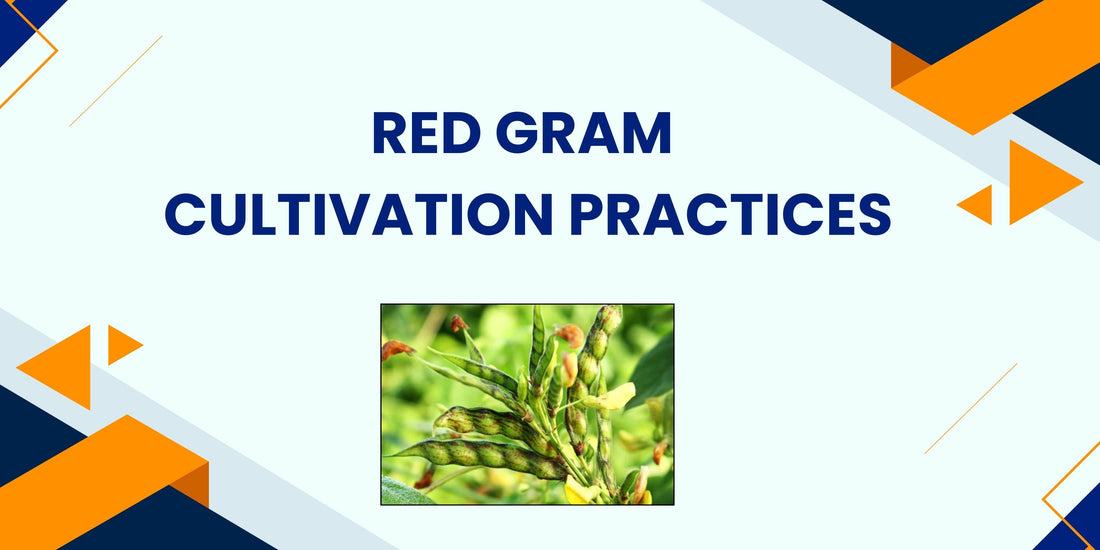
REDGRAM CULTIVATION PRACTICES
Scientific name: Cajanus cajan
Telugu Name: Kandi
Introduction:
India is the world's top producer as well as consumer of red gram. Red gram is a basic meal, which is high in protein. The majority of the country's vegetarian population gets its protein from red gram. Red gram is mostly ingested as split pulse known as Dal, which is a crucial addition to a diet focused on cereal. The staples of the typical Indian diet are either Dal-Chawal (pulse-rice) or Dal-Roti (pulse-wheat bread). Due to the complementary nature of the necessary amino acids, when wheat or rice is coupled with red gram, the biological value increases significantly. Lysine, riboflavin, thiamine, niacin, and iron are particularly abundant.
Red gram is a significant source of both human food and animal feed, and it also contributes significantly to maintaining soil fertility by enhancing the physical characteristics of the soil and fixing atmospheric nitrogen. It is good for dryland farming and is typically grown as an intercrop with other crops since it is a drought-resistant crop.
Climatic Conditions:
Red gram can only be grown in climates that are mostly tropical or subtropical. It prefers an environment that is mostly warm and damp throughout vegetative growth. However, cold, sunny days are essential for fruit ripening and pod development during flowering. It is grown in an area where the summer time high is 20 to 30 degrees and the wintertime low is 17 to 22 degrees. Temperatures can reach 40°C, although 20 to 28°C is ideal. Because of a deep root structure, the crop is severely damaged by cloudy conditions and significant rainfall during flowering. grows up to 1500 meters above mean sea level and receives evenly spaced 500 to 900 mm of rainfall.
Soil requirement:
It thrives in a variety of soil types, from sandy loams to clay loams. But loamy soil that is rich and well-drained is ideal for it. Soils Pigeon pea farming benefits from alluvial and loamy soils that have adequate drainage. Because it is highly vulnerable to waterlogging during the seedling stage, it may also be cultivated on thick soils with sufficient drainage. It may grow well in soils with a pH range of 6.5 to 7.5.
Land preparation:
As a crop with deep roots, it needs a deep, finely ground, appropriately named, and well-drained seed bed. It is crucial to deep-plough using a soil-turning plough to a depth of 15 cm, followed by 2-3 discing and harrowing operations, and finally, planking. If leveling is required, it should be done to prevent water stagnation, guarantee consistent irrigation, and ensure correct drainage.
Varieties:
Medium duration: LRG-41, ICP-8863, ICPL-332, ICPL-87119, MRG-66, ICPL-85063, WRG-27, PRG-158, MRG-1004, WRG-53, WRG-65, TDRG-4, ICPH-2740 (hybrid)
Short duration: ICPL-84031 (Durga), ICPL-85010 and CORG-9701, PRG176
Wilt resistant varieties (hybrid): ICPL-87119, ICP-8863, WRG-65, TDRG-4, ICPH-2740.
Seeds and Sowing:
Either broadcasting, line sowing, or dribbling are used to plant seeds. Sprinkle the seeds at the suggested distances. Varieties, hybrids, and cropping strategies all affect the seed rate and spacing.
Seed Rate:
- Medium duration varieties: 5-10 kg/ha
- Short duration varieties: 15-18 kg/ha depending on the type of soil and spacing.
Seed Treatment:
Treat the seeds with Fungicide: Thiram (2gm) + Carbendazim (1gm) or Thiram @ 3 gm or Tricoderma virdie 5- 7g /kg of seed; Culture: Rhizobium and PSB culture 7-10 g /kg seed.
Weed Management:
During its first 60 days of development, Red gram is extremely susceptible to weed competition. The crop grows quickly when protected at this time, and weeds have no further impact on its development. Spray fluchloralin at a rate of 1.5 lit per ha or pendimethalin at a rate of 2 lit per ha three days after planting, followed by irrigation. Uncontrolled weeds also reduce pigeon pea output by 21–97%.
Water Management:
Irrigation and Drainage Being a deep rooted crop, it can tolerate drought. But in case of prolonged drought there is need of three irrigation 1st at branching stage (30 DAS) 2nd one in flowering stage (70 DAS) and 3rd at the time of podding stage (110 DAS). A pre-requisite for the success of pigeonpea is proper drainage. Ridge planting is effective in areas where sub-surface drainage is poor. This provide enough aeration for the roots during the period of excess rainfall.
Nutrient Management:
As a base dressing, farmyard manure, compost (12.5 t/ha), or vermicompost (5.0 t/ha) are used. For rainfed and irrigated situations, applications of 12.5:25 and 25:50 kg of N: P per ha are suggested, respectively. Early-stage seedlings rely on the nitrogen in the soil and do respond to a starting dosage of 15 to 20 kg N/ha.
Harvesting:
Red gram plants should be harvested when 80% of the pods are fully developed. For a few days, stack the plants. Using sticks, divide the pods, remove the husk from the grains, and dry them to an ideal moisture level (10–12%). When 75% of the pods become brown, the crop is harvested.
With a sickle, the harvest is carried out by cutting from 75 to 250 meters above the ground. Harvested plants are allowed to sun dry. Either a mechanical thresher or a person pounding the pods with a stick is used for threshing.
Yield:
With use of improved technology of agronomic practices pigeon pea may yield about 25-30 q/ha from irrigated condition and 15-20 q/ha from un-irrigated condition. (depending upon maturity group of variety and climate) and 50-60 q/ha of sticks for fuel, as well.
